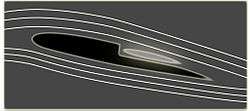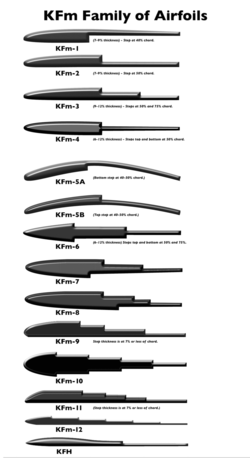Kline–Fogleman airfoil
The Kline–Fogleman airfoil or KF airfoil is a simple airfoil design with single or multiple steps along the length of the wing. It was originally devised around 50 years ago for paper airplanes.


In the 21st century the KF airfoil has found renewed interest among hobbyist builders of radio-controlled aircraft, due to its simplicity of construction.[1] But it has not been adopted for full-size aircraft capable of carrying a pilot, passengers, or other substantial payloads.
History
The KF airfoil was designed by Richard Kline and Floyd Fogleman.

In the early 1960s, Richard Kline wanted to make a paper airplane that could handle strong winds, climb high, level off by itself and then enter a long downwards glide. After many experiments he was able to achieve this goal. He presented the paper airplane to Floyd Fogleman who saw it fly and resist stalling. The two men then filed for a patent on the stepped airfoil.
Further development resulted in two patents and a family of airfoils known as the KF airfoil and KFm airfoils (for Kline–Fogleman modified). The two patents, US Patent # 3,706,430 and US Patent # 4,046,338, refer to the introduction of a step either on the bottom (KFm1) or on the top of an airfoil (KFm2), or both on top and bottom (KFm4). It can also be used with two steps on the top (KFm3), or two steps on the top and one on the bottom (KFm7).
The purpose of the step, it is claimed, is to allow some of the displaced air to fall into a pocket behind the step and become part of the airfoil shape as a trapped vortex or vortex attachment. This purportedly prevents separation and maintains airflow over the surface of the airfoil.
Reception
Time published an April 2, 1973 article,The Paper-Plane Caper[2] about the paper airplane and its Kline–Fogleman airfoil.
Also in 1973, CBS 60 Minutes did a 15-minute segment on the KF airfoil. It repeated the show again in 1976.
In 1985, Kline wrote a book entitled "The Ultimate Paper Airplane".[3] To publicize the book, he went down to Kill Devil Hills, NC in 1985, to the site where the Wright Brothers first flew where their first manned powered flight went 122 feet. A crew from Good Morning America came along to film the event. The longest flight by Kline with his paper airplane traveled 401 feet, four inches.
Independent scientific testing

In 1974, a NASA-funded study prompted by Kline and Fogelman's claims and the resulting national coverage found the airfoil to have worse lift-to-drag ratio than a flat plate airfoil in wind tunnel tests.[4]
In the 1990s, with 20 years of technical progress opening up new possibilities and with the original patents expired, researchers returned to the topic of stepped wings. A 1998 study by Fathi Finaish and Stephen Witherspoon at the University of Missouri tested numerous step configurations in a wind tunnel.[5] While many made wing performance worse, they got promising results with backward-facing steps on the lower surface of the wing – in some cases giving considerable enhancement in lift without much of a drag penalty. However, they concluded that a single configuration could not be best solution at every angle of attack and flight speed. Indeed, "vastly different configurations may be needed during a single maneuver." The idea works, Finaish and Witherspoon concluded, but only with active automated re-configuration of the shape of the step(s) during flight. Further testing has shown that this airfoil is effective in low Reynolds number flow.
A 2008 study by Fabrizio De Gregorio and Giuseppe Fraioli at CIRA and the University of Rome in Italy tried this out.[6] The model aerofoils used in their wind tunnel tests were equipped with numerous small holes through which air could be blown or sucked in an active way.
They concluded that the trapped vortex formed by a cavity or step could not be held in place without such active control. Just relying passively on wing shape wasn't enough – the vortex would detach possibly giving you worse characteristics than the original unstepped airfoil. But when active controls were used to keep the vortex stably in place they found the results "really encouraging".
Such scientific experimental work seems to have put paid to the idea that the original KF airfoil will find a simple practical application in the world of full-size aircraft. But the basic idea of the stepped wing has mutated, and is now bound up with a new body of research into actively controlling the airflow over a wing's surface with new mechanisms unthinkable 50 years ago.
The case study conducted as a part of this research focuses on the UAV RQ-2 Pioneer employed in a stepped airfoil configuration by comparing its aerodynamic characteristics with the conventional NACA 4415 airfoil originally used on this aircraft. The main objective of the case study was to identify and outline a step schedule for the flight envelope of the UAV Pioneer using a stepped airfoil configuration at the same time applying active flow control to obtain enhanced aerodynamic performance over conventional NACA 4415 airfoil originally used and hence improve the flight performance characteristics like Range and Endurance of the aircraft.[7]
Applications of the KF airfoil today

Poor lift-to-drag ratio performance in wind tunnel testing has meant that to date the KF airfoil has not been used on any full size aircraft. But the KF airfoil and derivative 'stepped' airfoils have in recent years gained a following in the world of foam constructed radio controlled model aircraft. The low Reynolds numbers allow for the stepped airfoils to produce a significant amount of lift for the drag incurred, making them increasingly popular among RC hobbyist.
The simple KF airfoil shape lends itself well to construction in sheets of various plastic foams, typically expanded polystyrene (EPS) or expanded polypropylene (EPP). The resulting stepped wing can have improved performance and flying characteristics compared to the even simpler 'flat plate' wing used in some radio-controlled models. The Airfoils illustrated in this article are examples of those used in radio control foam models.
The first man carrying KF airfoil based aircraft was successfully flown in 1987 by Richard Wood in Canada. (The Recreational Flyer Magazine November December 1991) Top speed was higher and stall was slower (The Recreational Flyer Magazine. November / December 1991). The airfoil was tested on a Vector 600 ultralight.
The KF airfoil has been applied to the Darrieus wind turbine using a trapped vortex. Experiments have found the KF rotor demonstrates a higher static and dynamic torque with low Reynolds applications and better performance for wind conditions lower than 0.8 m/s. It is seen a potential solution for self-starting in the Darrieus wind turbine.
Patents
- U.S. Patent 3,706,430 AIRFOIL FOR AIRCRAFT, filed March 17, 1970, issued December 1972
- U.S. Patent 4,046,338 Airfoil for aircraft having improved lift generating device, filed October 14, 1975, issued September 6, 1977
References
- Example of discussion at RC Groups forum
- "Science: The Paper-Plane Caper". TIME. 1973-04-02. Retrieved 2012-05-13.
- Richard Kline (1985). The Ultimate Paper Airplane: With Step-by Step Instructions for Seven Different Models. Simon and Schuster. ISBN 978-0-671-55551-1.
- Lumsdaine, Edward (1974-12-15). "Investigation of the Kline-Fogleman Airfoil Section for Rotor Blade Applications" (PDF).
- Aerodynamic Performance Of An Airfoil With Step-Induced Vortex For Lift Augmentation, Journal of Aerospace Engineering, January 1998
- "Flow Control On A High Thickness Airfoil By A Trapped Vortex Cavity, 14th Int Symp on Applications of Laser Techniques to Fluid Mechanics, Lisbon July 2008" (PDF). Archived from the original (PDF) on 2012-03-20. Retrieved 2012-05-13.
- Voona, Ranganadhan (2012). Enhancing the aerodynamic performance of stepped airfoils Numerical and Experimental Study (1. Aufl. ed.). Saarbrücken: LAP LAMBERT Academic Publishing. pp. 45–54. ISBN 978-3-659-26600-3.